-
Welcome to the Community Forums at HiveWire 3D! Please note that the user name you choose for our forum will be displayed to the public. Our store was closed as January 4, 2021. You can find HiveWire 3D and Lisa's Botanicals products, as well as many of our Contributing Artists, at Renderosity. This thread lists where many are now selling their products. Renderosity is generously putting products which were purchased at HiveWire 3D and are now sold at their store into customer accounts by gifting them. This is not an overnight process so please be patient, if you have already emailed them about this. If you have NOT emailed them, please see the 2nd post in this thread for instructions on what you need to do
You are using an out of date browser. It may not display this or other websites correctly.
You should upgrade or use an alternative browser.
You should upgrade or use an alternative browser.
This is such a neat thread.  I'll have to dig around for photos... as much as I hate photos of ME being taken, I have quite a few of various pets over the years. LOL
I'll have to dig around for photos... as much as I hate photos of ME being taken, I have quite a few of various pets over the years. LOL
Bettas!! Wow, yours have some really gorgeous coloring, Rae! We currently have one old man of a betta; actually he's almost 3 years old now, and we're actually shocked that he's still alive given his age. He's a fiesty little stinker, though. I'll have to get a photo of him - my pup named him Paco. LOL He's not quite as colorful as yours, but we like him.
Loved the horse photos also. You really dodged a bullet with the cervical break, though. It might seem unbelievable, but if it was such a small break, it is VERY easy to not be able to see it on an xray. I've got three different vertebrae in my neck that were "cracked" at one time or another. Only one of those was found on an x-ray at the time it happened. The other two were not spotted until quite some time later.
LOL! I have had cats who do that constantly. Love your nicknames for the puppies, Lorraine. They're all gorgeous animals!
Szark, that is a new breed to my knowledge also. I love their fur. They are beautiful animals!
The red, white and blue one was my fave over the years (I've even sold a couple of cards with that image on them)
Bettas!! Wow, yours have some really gorgeous coloring, Rae! We currently have one old man of a betta; actually he's almost 3 years old now, and we're actually shocked that he's still alive given his age. He's a fiesty little stinker, though. I'll have to get a photo of him - my pup named him Paco. LOL He's not quite as colorful as yours, but we like him.
Loved the horse photos also. You really dodged a bullet with the cervical break, though. It might seem unbelievable, but if it was such a small break, it is VERY easy to not be able to see it on an xray. I've got three different vertebrae in my neck that were "cracked" at one time or another. Only one of those was found on an x-ray at the time it happened. The other two were not spotted until quite some time later.
This is Bruin the Wonderdog
LOL! I have had cats who do that constantly. Love your nicknames for the puppies, Lorraine. They're all gorgeous animals!
Szark, that is a new breed to my knowledge also. I love their fur. They are beautiful animals!
I just found out recently that sometimes it can take weeks for a fracture to appear on Xrays so its not surprising. Funny thing is I've always had a slight pain there, now I know why 
I was really lucky with my "patriotic" Betta, I'd never seen one with that colouring so I had to snap him up Can't wait to see a pic yours, I'm sure he's just as wonderful.
Can't wait to see a pic yours, I'm sure he's just as wonderful.
I'm loving seeing everyones fur families (and yes, I include feathered and scaled members in the fur category), I can't wait to see some of the weird ones that I know some will have (well, I can wait if they have more than 6 legs, I don't do 8 legged critters very well )
)
I was really lucky with my "patriotic" Betta, I'd never seen one with that colouring so I had to snap him up
I'm loving seeing everyones fur families (and yes, I include feathered and scaled members in the fur category), I can't wait to see some of the weird ones that I know some will have (well, I can wait if they have more than 6 legs, I don't do 8 legged critters very well
Ok... so here's a few of my pet pictures. We have had furbabies and scale-babies both, though this one is just the kitties. 
Tattianna, from one of the other threads (I forget which one I posted her in), was my half-Maine Coon girl :

And this was an early photo of the litter that our Copilot is from (he's the silly dope on the far left...LOL)

And this was another photo from that night. Copilot, once again, being the dopey one in the middle that's being all clumsy and awkward. LOL the others were Benjamin, Little Lady, T-Bone, and Zipper.

I'm sharing this one because Benjamin is the one in the middle with the blue eyes. We had homes already prepared to take all but two of the litter. Benjamin was deaf. Both of his eyes were blue, and it was obvious very quickly that he could not hear anything, so we were intending to keep him, rather than risk putting him in a home with a family that might or might not be able to deal with how to live with a deaf cat.
He was also the runt of the litter; he was the smallest of the bunch, and he really was very sweet. I took to him entirely too quickly, and we actually thought he was going to make it. He died at about six months old, though, with a common issue for tabby and part-tabby male kittens - liver failure.
Anyway. I still have a soft spot for the little guy, even 13 years later, so I had to include him here.
And yes, that would be Copilot, once again being the oddball in the kitten-pile with his back turned. LOL

And this would be momma and two of the kittens. Momma here was Alexandria - she was a feral that we brought in off the street when she was about six months old. The kitten on the left was Little Lady - she had one blue eye and one green eye. The other kitten was definitely our deaf kitten Benjamin, though the flash from the camera (remember those cameras!!
Momma here was Alexandria - she was a feral that we brought in off the street when she was about six months old. The kitten on the left was Little Lady - she had one blue eye and one green eye. The other kitten was definitely our deaf kitten Benjamin, though the flash from the camera (remember those cameras!!  ) did have a habit of sometimes turning his eyes green in photos, and sometimes leaving them fully blue. I did say he was tiny!
) did have a habit of sometimes turning his eyes green in photos, and sometimes leaving them fully blue. I did say he was tiny!

One last one of a kitten when the litter was still young. I just always liked how this came out. It reminded me a little bit of the pictures you see in books or on bookmarks/covers and such.

And these three would be Mocha (the chocolate point Balinese), Kiko (the female in the blue collar), and Rasha (he was Copilot's poppa. LOL)

And this is one of our two current kitties - Daisy (no she is not related to the kitty in the previous photo). This is her and the Betta fish (Paco) playing their usual game. Betta swims around the bowl, stops and stares at kitty. Kitty stares through bowl at Betta. Betta stares back, flicks his tail, then swims around the bowl again and resumes staring smugly at kitty. Betta has figured out by now that kitty can't actually get him through the bowl. LOL

And this is another typical of Daisy... she is not happy unless she is curled up with one of the sleeping females. If both my pup and I are sleeping at the same time, this cat goes NUTS trying to go back and forth between both of us. It's actually kind of funny, and cute...
This was Daisy and my not-so-little pup...
Off-note... the crochet blanket the pup is using as a pillow is a blanket I made when I was carrying her. It's older than she is by about six months. And even at 17 years old, she will not go ANYWHERE WITHOUT IT. LOL

And that's it for the kitty post.
I did mention that I've lived with multiple animals for most of my life, right...
Tattianna, from one of the other threads (I forget which one I posted her in), was my half-Maine Coon girl :
And this was an early photo of the litter that our Copilot is from (he's the silly dope on the far left...LOL)
And this was another photo from that night. Copilot, once again, being the dopey one in the middle that's being all clumsy and awkward. LOL the others were Benjamin, Little Lady, T-Bone, and Zipper.
I'm sharing this one because Benjamin is the one in the middle with the blue eyes. We had homes already prepared to take all but two of the litter. Benjamin was deaf. Both of his eyes were blue, and it was obvious very quickly that he could not hear anything, so we were intending to keep him, rather than risk putting him in a home with a family that might or might not be able to deal with how to live with a deaf cat.
He was also the runt of the litter; he was the smallest of the bunch, and he really was very sweet. I took to him entirely too quickly, and we actually thought he was going to make it. He died at about six months old, though, with a common issue for tabby and part-tabby male kittens - liver failure.
Anyway. I still have a soft spot for the little guy, even 13 years later, so I had to include him here.
And yes, that would be Copilot, once again being the oddball in the kitten-pile with his back turned. LOL
And this would be momma and two of the kittens.
One last one of a kitten when the litter was still young. I just always liked how this came out. It reminded me a little bit of the pictures you see in books or on bookmarks/covers and such.
And these three would be Mocha (the chocolate point Balinese), Kiko (the female in the blue collar), and Rasha (he was Copilot's poppa. LOL)
And this is one of our two current kitties - Daisy (no she is not related to the kitty in the previous photo). This is her and the Betta fish (Paco) playing their usual game. Betta swims around the bowl, stops and stares at kitty. Kitty stares through bowl at Betta. Betta stares back, flicks his tail, then swims around the bowl again and resumes staring smugly at kitty. Betta has figured out by now that kitty can't actually get him through the bowl. LOL
And this is another typical of Daisy... she is not happy unless she is curled up with one of the sleeping females. If both my pup and I are sleeping at the same time, this cat goes NUTS trying to go back and forth between both of us. It's actually kind of funny, and cute...
This was Daisy and my not-so-little pup...
Off-note... the crochet blanket the pup is using as a pillow is a blanket I made when I was carrying her. It's older than she is by about six months. And even at 17 years old, she will not go ANYWHERE WITHOUT IT. LOL
And that's it for the kitty post.
I did mention that I've lived with multiple animals for most of my life, right...
Last edited:
I just found out recently that sometimes it can take weeks for a fracture to appear on Xrays so its not surprising. Funny thing is I've always had a slight pain there, now I know why
Yes, sometimes it can take that long before they show up. I've had many, many breaks over the years, some of which didn't show up on the x-rays for quite some time. At this point I look more like a jigsaw puzzle than anything else on an xray, so I can't blame any doctor for not being able to spot ONE break among all of them.
But yes, it can actually take that long. Especially for the thinner/hairline/more minor fractures.
Ok... these are some of the scale-babies from over the years. 
Out of respect for the fact that many folks strongly, strongly DO NOT like snakes... these are just going to be inserted as thumbnails, so those folks don't have large pictures popping up in their faces. If you don't like snakes, don't click on the thumbnails! LOL
If you don't like snakes, don't click on the thumbnails! LOL
First one here... this was an albino California Kingsnake of my Bear's... he nicknamed this critter "Elttar," because of his behavior. Yes, it's "Rattle" spelled backwards. Yes, it was intentional. This breed of snake is very small for much of it's life (though it will eventually reach a good 4-5ft in adult size), and it has developed a rather interesting defense mechanism.
The tip of it's tail has a hardened group of scales on it, and when threatened or aggressive, this animal will shake it's tail - HARD - back and forth against a hard surface. The effect produces a sound that is fairly similar to that of a rattlesnake's rattle. They've also mastered the art of the "rattlesnake s-curve" as well. They are quite fiesty. This little guy was convinced he was a big bad rattler.... LOL
This is for size comparison - on my Bear's hands...
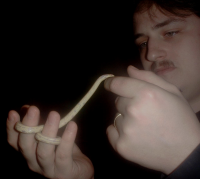
And this is what I meant about the rattlesnake S-curve. This was his enclosure. These guys don't appreciate a lot of moisture, except when they are getting ready to shed, and even then they don't really like a LOT of it.

And this would be our African Rock Python - he was named Ka the Second, and was the tamest rock python we've ever worked with, to be honest. These photos were taken when he was a juvenile, not long after we got him. He was a rescue animal that became a family member scale-baby and we kept him. These guys hatch at a pretty good size right out of the egg. They're a pretty aggressive breed, but when we got him, he was about 4 foot long, so he was still pretty young. The former owner had gotten him as a hatchling, and was not prepared for the aggressiveness, nor did he know how to deal with it. Basically, he was afraid of the animal, and wanted to get rid of it.
We took him in, and worked with him very heavily. By the time he was eight foot long, he was rather docile with us for the most part, but we did not ever allow him out of the tank around any but the three of us. Our daughter was very little when we first got him; she's kind of grown up around a whole menagerie of critters.... mostly my fault. LOL
These animals are very, very strong, extremely methodical, highly inquisitive, and very, very smart as snakes go. Rock pythons are one of the few snakes that will actively hunt. And they will operate on land, in the trees, AND in the water. They are known for stalking common water holes, and will submerge all but their nostrils. And there they will sit, until something comes along that they think they can make a meal out of. In the wild, crocodiles are on the menu for these guys. Having one in the home is a very interesting experience, I do have to say. You have GOT to respect the animal, and they have GOT to be handled on a regular basis, or they will very quickly revert to a half-wild or full-wild state, unlike most pythons.
Part of keeping him securely contained in his enclosure involved about fifty pounds of weights to keep him from pushing his lid off. By the time he died, he was 17 years old, and measured in at about 12 1/2 foot long. He just died of old age, really.
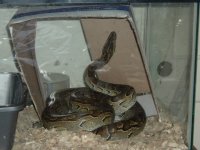
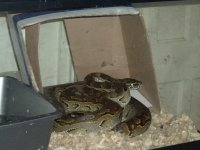
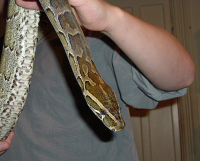
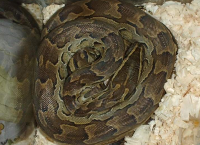
And this was Kali. This little thing was just your common Corn Snake. Far too many people confuse these guys with the poisonous Copperheads...
These also do not get very big; about 4-5 foot long at their full grown size. Kali was a juvenile in this picture. These guys also REALLY like to climb... and they are experts at using the ends of their tails to anchor and swing from...

And this was si'Haya - she was a Ball Python. Again, these max out around 4-5 foot long, but they tend to be rather fat-bodied snakes, though the females have more bulk than the males. This animal was also a rescue... though we "rescued" her from a rather horrid little pet store. She had mites, infected bites from being fed live food, mouth rot, she had multiple layers of shed remnants in a few spots showing both dehydration and a lack of proper environment for her to shed in, she was both malnourished and dehydrated.
We actually didn't expect her to survive. We expected to bury her within a day or two, and my Bear thought I was completely nuts when I insisted on taking her home. But sick or not, this little thing stood right up in her tank and stared RIGHT AT ME when we first spotted the tank. And I do mean stared. We really didn't think she would live, but dangit, I had to TRY!! I couldn't make myself walk away from her. LOL
We pretty much went from the pet shop straight to an exotics vet. She surprised everyone - including me and my Bear - she lived about 15 years, and actually did recover nicely, which is.. very, very rare for snakes, especially young ones, to do with the kinds of things she had wrong when we took her home.
I took perhaps a little too much satisfaction in turning the shop in, as well. They had horrible, horrible conditions in there for all of their animals, but the reptile enclosures were REALLY bad. But she actually lived quite a long time, considering the type of state she was in when we first brought her home. It took a lot of work to get her healthy, but it was worth it.
Anyway. They are called Ball Pythons for a reason. THIS is what they like to do - she was still a juvenile here...
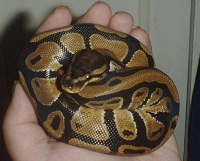
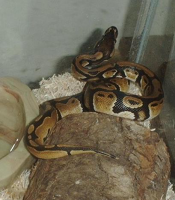
And this was Tsu. He was a juvenile Burmese Python... also a rescue and eventually went to a good home.

Yes, we've done a lot of rescues over the years when it comes to the reptiles. Really, you KNOW you're a Herp caretaker when you open your freezer to pull meat out for dinner, reach PAST the bag of frozen snake food, and you don't even THINK about it. LOL
Other snakes we've worked with over the years... hrm. Let's see... An Indonesian Tree Boa named Tabitha. Adult, fully grown mature size : 12 inches. Yes, INCHES. lol An Indonesian Ground Boa... adult size, 3 foot long. We've also worked with/rehabilitated reticulated pythons, columbian red-tailed boas, bullsnakes, rainbow boas...
This past winter was the first winter we've had in our entire marriage, that we did NOT have a snake of some sort in the house. And lacking that animal, the field mice have been coming in regularly... Daisy has definitely been earning her keep with mousing! We never had ANY mice in the house before... this is not a coincidence, IMO.
Let's see... I've also trailed raccoons, various birds, gerbils, rabbits, chipmunks, and squirrels through the house at one point or another... oh, and then there was the one red-tail hawk from years ago... I nicknamed him Screech, LOL. He was just barely old enough to be flying around on his own, and got caught up in someone's porch gutter... I called him Screech because that's what he did when he was unhappy about something. Happily released him once his wing was functional again and he was eating again. I still have a couple of small scars on my arms from his talons... I would not have dared try that with an adult, but Screech was just a juvenile and small enough for me to work with.
I would not have dared try that with an adult, but Screech was just a juvenile and small enough for me to work with.
My Bear has put up with me dragging an entire zoo through our house at one time or another. LOL We have not had any dogs during the course of our marriage, but I think the kitties and snakes more than make up for that. We've had reptiles for so long, that our daughter doesn't even bat an eyelash at them - but she will jump out of her skin at the sight of a pencil eraser-sized spider!
Those who have asked my husband how he puts up with the constant trail of critters (seriously, sometimes they're only here for a day or two until we find their original owners or maybe a week or two to find a good home...).
Anyway. He tends to just laugh at people who ask him that question. "It's part and parcel of being married to a Native girl. You get used to it.. and you stop asking questions. At least she doesn't bring anything poisonous home."
LOL
Out of respect for the fact that many folks strongly, strongly DO NOT like snakes... these are just going to be inserted as thumbnails, so those folks don't have large pictures popping up in their faces.
First one here... this was an albino California Kingsnake of my Bear's... he nicknamed this critter "Elttar," because of his behavior. Yes, it's "Rattle" spelled backwards. Yes, it was intentional. This breed of snake is very small for much of it's life (though it will eventually reach a good 4-5ft in adult size), and it has developed a rather interesting defense mechanism.
The tip of it's tail has a hardened group of scales on it, and when threatened or aggressive, this animal will shake it's tail - HARD - back and forth against a hard surface. The effect produces a sound that is fairly similar to that of a rattlesnake's rattle. They've also mastered the art of the "rattlesnake s-curve" as well. They are quite fiesty. This little guy was convinced he was a big bad rattler.... LOL
This is for size comparison - on my Bear's hands...

And this is what I meant about the rattlesnake S-curve. This was his enclosure. These guys don't appreciate a lot of moisture, except when they are getting ready to shed, and even then they don't really like a LOT of it.

And this would be our African Rock Python - he was named Ka the Second, and was the tamest rock python we've ever worked with, to be honest. These photos were taken when he was a juvenile, not long after we got him. He was a rescue animal that became a family member scale-baby and we kept him. These guys hatch at a pretty good size right out of the egg. They're a pretty aggressive breed, but when we got him, he was about 4 foot long, so he was still pretty young. The former owner had gotten him as a hatchling, and was not prepared for the aggressiveness, nor did he know how to deal with it. Basically, he was afraid of the animal, and wanted to get rid of it.
We took him in, and worked with him very heavily. By the time he was eight foot long, he was rather docile with us for the most part, but we did not ever allow him out of the tank around any but the three of us. Our daughter was very little when we first got him; she's kind of grown up around a whole menagerie of critters.... mostly my fault. LOL
These animals are very, very strong, extremely methodical, highly inquisitive, and very, very smart as snakes go. Rock pythons are one of the few snakes that will actively hunt. And they will operate on land, in the trees, AND in the water. They are known for stalking common water holes, and will submerge all but their nostrils. And there they will sit, until something comes along that they think they can make a meal out of. In the wild, crocodiles are on the menu for these guys. Having one in the home is a very interesting experience, I do have to say. You have GOT to respect the animal, and they have GOT to be handled on a regular basis, or they will very quickly revert to a half-wild or full-wild state, unlike most pythons.
Part of keeping him securely contained in his enclosure involved about fifty pounds of weights to keep him from pushing his lid off. By the time he died, he was 17 years old, and measured in at about 12 1/2 foot long. He just died of old age, really.




And this was Kali. This little thing was just your common Corn Snake. Far too many people confuse these guys with the poisonous Copperheads...
These also do not get very big; about 4-5 foot long at their full grown size. Kali was a juvenile in this picture. These guys also REALLY like to climb... and they are experts at using the ends of their tails to anchor and swing from...

And this was si'Haya - she was a Ball Python. Again, these max out around 4-5 foot long, but they tend to be rather fat-bodied snakes, though the females have more bulk than the males. This animal was also a rescue... though we "rescued" her from a rather horrid little pet store. She had mites, infected bites from being fed live food, mouth rot, she had multiple layers of shed remnants in a few spots showing both dehydration and a lack of proper environment for her to shed in, she was both malnourished and dehydrated.
We actually didn't expect her to survive. We expected to bury her within a day or two, and my Bear thought I was completely nuts when I insisted on taking her home. But sick or not, this little thing stood right up in her tank and stared RIGHT AT ME when we first spotted the tank. And I do mean stared. We really didn't think she would live, but dangit, I had to TRY!! I couldn't make myself walk away from her. LOL
We pretty much went from the pet shop straight to an exotics vet. She surprised everyone - including me and my Bear - she lived about 15 years, and actually did recover nicely, which is.. very, very rare for snakes, especially young ones, to do with the kinds of things she had wrong when we took her home.
I took perhaps a little too much satisfaction in turning the shop in, as well. They had horrible, horrible conditions in there for all of their animals, but the reptile enclosures were REALLY bad. But she actually lived quite a long time, considering the type of state she was in when we first brought her home. It took a lot of work to get her healthy, but it was worth it.
Anyway. They are called Ball Pythons for a reason. THIS is what they like to do - she was still a juvenile here...


And this was Tsu. He was a juvenile Burmese Python... also a rescue and eventually went to a good home.

Yes, we've done a lot of rescues over the years when it comes to the reptiles. Really, you KNOW you're a Herp caretaker when you open your freezer to pull meat out for dinner, reach PAST the bag of frozen snake food, and you don't even THINK about it. LOL
Other snakes we've worked with over the years... hrm. Let's see... An Indonesian Tree Boa named Tabitha. Adult, fully grown mature size : 12 inches. Yes, INCHES. lol An Indonesian Ground Boa... adult size, 3 foot long. We've also worked with/rehabilitated reticulated pythons, columbian red-tailed boas, bullsnakes, rainbow boas...
This past winter was the first winter we've had in our entire marriage, that we did NOT have a snake of some sort in the house. And lacking that animal, the field mice have been coming in regularly... Daisy has definitely been earning her keep with mousing! We never had ANY mice in the house before... this is not a coincidence, IMO.
Let's see... I've also trailed raccoons, various birds, gerbils, rabbits, chipmunks, and squirrels through the house at one point or another... oh, and then there was the one red-tail hawk from years ago... I nicknamed him Screech, LOL. He was just barely old enough to be flying around on his own, and got caught up in someone's porch gutter... I called him Screech because that's what he did when he was unhappy about something. Happily released him once his wing was functional again and he was eating again. I still have a couple of small scars on my arms from his talons...
 I would not have dared try that with an adult, but Screech was just a juvenile and small enough for me to work with.
I would not have dared try that with an adult, but Screech was just a juvenile and small enough for me to work with.My Bear has put up with me dragging an entire zoo through our house at one time or another. LOL We have not had any dogs during the course of our marriage, but I think the kitties and snakes more than make up for that. We've had reptiles for so long, that our daughter doesn't even bat an eyelash at them - but she will jump out of her skin at the sight of a pencil eraser-sized spider!
Those who have asked my husband how he puts up with the constant trail of critters (seriously, sometimes they're only here for a day or two until we find their original owners or maybe a week or two to find a good home...).
Anyway. He tends to just laugh at people who ask him that question. "It's part and parcel of being married to a Native girl. You get used to it.. and you stop asking questions. At least she doesn't bring anything poisonous home."
LOL
Last edited:
Szark
Awesome
1 Nice Siamese Fighting fish there. Breed them when I was 14 and had 5 fish tanks in my bedroom, biggest 3foot long. Totally captivating watching them build a bubble nest etc
2 Love all the cats pics the dog thinks it is a menu. Seriously I like cats but so many owner leaves them to roam and crap in my garden and eat my pond fish and over here they are having a negative effect on wildlife. My dog only kill vermin, rabbits and the USA Grey Squirrel.
Oh I love snakes too, very cool. The only reason why I won't have snakes and things like that is because we cannot feed them live food legally.
2 Love all the cats pics the dog thinks it is a menu. Seriously I like cats but so many owner leaves them to roam and crap in my garden and eat my pond fish and over here they are having a negative effect on wildlife. My dog only kill vermin, rabbits and the USA Grey Squirrel.
Oh I love snakes too, very cool. The only reason why I won't have snakes and things like that is because we cannot feed them live food legally.
Wow Seliah that is an awful lot of animals...They all look really cute though...except the snakes lol
Yes, a lot of people are perfectly happy if they never see a snake in their life. That's WHY the pictures I posted were thumbnails, not full-size inserts. LOL Herps/snakes/reptiles are NOT for everyone, and they take a very different brand of animal husbandry to care for - and appreciate.
LOL yes thank god you don't bring the poisonous ones home Seliah!
Awesome scalies and such cute kitties (and I don't blame your daughter, I hate anything that has more than 6 legs, isn't 6 enough?)
LOL! Yes, she once told me that if the spider was big enough for her to count the legs, it was big enough for her to squash!
 I actually love wolf spiders... but then I'm weird that way.. and wolf spiders are fuzzy!
I actually love wolf spiders... but then I'm weird that way.. and wolf spiders are fuzzy!Very cute kitties, Seliah and I like your snakes! Gorgeous! But I'm still glad we don't have any here
You folks have enough wild life that thinks you're on the menu! You don't need these adding to it! LMAO
Oh I love snakes too, very cool. The only reason why I won't have snakes and things like that is because we cannot feed them live food legally.
I actually really enjoy the snakes. Not so much other reptiles. I have worked with things like iguanas before... I knew someone once who had a Caiman... uhm... I draw the line at miniature crocodiles, thanks-but-no-thanks! LOL
The live feed thing is really iffy... most of mine were fed frozen-thaw or fresh-kill. I have just seen WAY too many snakes who were eaten by an aggressive live-feed rat, or who died of things like septicemia from an infected bite delivered by a rat... the only snake I had that we HAD to feed live was the ball python up above. Balls are a finnicky breed to feed anyway, and she was VERY picky. It HAD to be a rat, it HAD to be white, it HAD to be male, and it HAD to be alive - or she would not eat.
seachnasaigh
Energetic
Sarah the spotty firedog...


Sarah the spotty firedog...
Oh, she is cute!!
Szark
Awesome
Man I thought I read a spotty frog. I just love all dogs me...ok I am mad about dogs. I can't help it as I have had one of those 1 in 1000000 dogs, and now I have another, George. Lanny isn't as clued on as George.Sarah the spotty firedog...

My exact reaction. Absolutely adorable.Oh, she is cute!!
